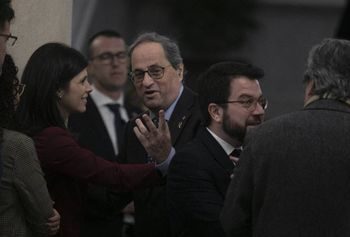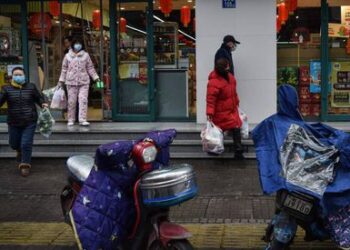
“Did you kill the son of your partner?”
“Yes”
That was how Ana Julia Quezada answered the first question from the public prosecutor Elena Fernández, at the start of her 100-minute testimony in an Almería court over the 2018 death of eight-year-old Gabriel Cruz. Quezada, who confessed to the killing last year after she was apprehended by police with the body of the youngster in the trunk of her car, only took questions from her own lawyer and the prosecutor on Tuesday. She was first asked by the judge, Alejandra Dodero, whether she pleaded guilty or innocent of the charges she is facing, of premeditated murder and psychological damage to the parents of the child. “Innocent,” she replied.
I wanted them to apprehend me. I couldn’t deal with it any more
Ana Julia Quezada
Quezada – who at times spoke through sobs, at others raised her voice, and often interrupted herself to ask forgiveness for her crime – has changed her version of the events of February 27, 2018, when she killed the eight-year-old son of her then-partner, Ángel Cruz, in the Andalusian village of Rodalquilar. She has also changed her account of the 11-day search for the child, in which she actively participated, and the circumstance of her arrest. The nine members of the jury heard two new elements in the case yesterday: that Quezada wanted to kill herself, and that she planted a shirt belonging to the child during the search efforts because she wanted to get caught.
“I wanted them to find me,” she told the court. “I wanted them to apprehend me. I couldn’t deal with it any more.”
The prosecutor, meanwhile, pointed out that during the investigative stage of the case, Quezada had told the judge in charge of the probe that she had planted the item of clothing “because she wanted to give hope” to Gabriel’s father.

In groups of three, the members of the jury had to come close to an audio player to clearly hear a recording from a device that had been planted by police in Quezada’s car. “Let’s see what I am going to do with you,” she is heard to have said on March 11, with the body of Gabriel in the trunk of her vehicle, shortly before her arrest. “Where shall I take you? To a greenhouse.”
But according to her testimony in court on Tuesday, she was actually planning on taking the child to the garage of the property in the Almería municipality of Vícar where she lived with Gabriel’s father. Quezada was, she told the court, planning to “go home and write two letters,” one for Ángel, her partner, and another for her daughter, explaining what had happened.
“I wanted to say sorry,” she said. “I wanted to leave my dog in the kitchen with water and food and the door of the terrace open. And to grab all the medication that I had, take it all and lie down on the sofa.”
Did you search for a video about the 10 most poisonous plants?
Elena Fernández, prosecutor
Questioned by the public prosecutor, Quezada recounted what happened on the day that Gabriel died. When they arrived at the family property in Rodalquilar that they were renovating, the child began to play with an ax.
“I said to him, ‘Put it down, you could hurt yourself.’ He started to shout, ‘You don’t tell me what to do, you’re not my mother. You’re black, you’re ugly, you’ve got an ugly nose, I don’t want you to be with my father. I want my father to marry my mother. I want you to go back to your country.’ He was shouting all of that stuff. I just covered up his mouth, I didn’t want to hurt the child. I just wanted him to shut up. I didn’t want to kill the child.” At that moment during her testimony, Quezada became very upset, and began to sob. Shortly beforehand, she said that Gabriel was a polite child, with whom she had not had any problems. Another witness, the psychologist Francisco Martín, noted that the child was “particularly well-behaved, sensitive, with an incredibly noble nature.”
The prosecutor was seeking to prove that there was premeditation ahead of the death. “Do you remember if you threw him against the wall? “No.” “Do you remember if he stamped his feet?” “No.” “Did you have blood on your hands?” “I don’t remember.” “Why didn’t you call an ambulance?” “I couldn’t call anyone!” the accused shouted. She added that she was nervous, and completely frozen, something that she repeated several times.
“I started to smoke like crazy. I went out, came back in, went out, came back in. I didn’t know what I was doing. In that time I must have smoked four, five, six, seven, eight cigarettes,” she continued. At that moment, she added, “I saw a shovel and I decided to dig a hole. […] I left the child and I went out to dig a small grave with a shovel that was in the garden. We were going to use that shovel to sort out the garden, just like the ax and the other tools.”
Quezada is facing Spain’s maximum penalty, permanent reviewable prison
Both the shovel and the ax were shown to the jury, as was the pink towel that Quezada used to partially cover the body of the child after digging him up days later.
The defendant explained how she dragged the body outside and stuck it “in the hole.” She returned to the room for the ax because “one of Gabriel’s hands was left outside.” She tried to chop his hand off with the ax, but said that she could not continue. (The autopsy revealed that she had broken the bones in his arm near his wrist.) “So I covered him up with earth,” she told the court.
The jury was also told about the events of March 11, when Quezada – who by this point was under surveillance by the Civil Guard – dug up the child and took advantage of the fact that his father was with his ex-partner. “I arrived at the property. I threw four stones at my dog, I uncovered Gabriel. I tried to touch him but I couldn’t.”
The jury was then shown the photos taken by the Civil Guard, of Quezada coming back and forth to the trunk of her car, with the body of the child.
The prosecutor also asked her about searches she had carried out on her computer. “Did you search for a video about the 10 most poisonous plants?” The defendant replied saying that she had a relative in Dominican Republic who is a beautician, and prepares face masks with those ingredients.
Victim’s mother comes face-to-face with defendant in court
The mother of victim Gabriel Cruz, Patricia Ramírez, gave testimony in court on Tuesday afternoon behind closed doors. Unlike other relatives of the eight-year-old boy, she chose not to be separated from the defendant, Ana Julia Quezada, by a screen, legal sources reported.
Ramírez gave testimony to the court for 30 minutes, as did the father of the child, Ángel Cruz, who did request for a screen to be placed between himself and the self-confessed killer Quezada, who was his partner at the time of the youngster’s death in February 2018.
The lawyer representing the child’s parents, Francisco Torres, told reporters that the day had been “very hard” for the parents, but had not provided “anything new.”
Torres explained that the parents, along with two other relatives of Gabriel, had confirmed the statements that they had made during the investigative phase of the case, and rejected the suggestion that the questions they were asked were “aimed at supporting” the charges of psychological damage to the parents that Quezada is facing.
Despite Quezada’s refusal to answer questions from the lawyer for the private prosecution, Francisco Torres, he wanted his line of questioning to be recorded on the official record for the trial. He asked how Quezada could explain the massive bleeding in the child’s brain that was found in the autopsy, whether Gabriel had helped her take the shovel and the ax out of the car, and whether she had previously tried to poison the child, “given that he had two episodes of gastroenteritis” after having been with her on Tuesdays, and if, when she removed his clothes, she was considering dismembering the body.
The defense lawyer, Esteban Hernández, asked Quezada some of the same questions. She replied that the shovel and the ax were already at the property, and at no time had she tried to poison Gabriel.
The court session on Tuesday also heard testimony from 10 more people. Among them, four direct relatives of Gabriel’s: his parents, Ángel Cruz and Patricia Ramírez, his cousin Mabel, and Carmen Sicilia, the grandmother of the eight-year-old. They did so in the afternoon behind closed doors, with no journalists present and no television feed. On their request, they were also separated from the defendant by a screen.
Quezada arrived at the Almería provincial courthouse a little before 9am on Tuesday. She is facing Spain’s maximum penalty, permanent reviewable prison – the equivalent of life with a possibility of parole after a fixed term – if the jury finds her guilty of murder. Her defense is pleading reckless homicide, claiming that the child attacked Quezada with a hatchet and that she acted in self-defense. The jury, made up of seven women and two men, will have to decide her fate.
Dozens of witnesses and experts have been summoned to the provincial court of Almería, where the trial is scheduled to end on September 19 after nine sessions.
“Did you try to poison him?”
Gabriel did not feel comfortable with the presence of his self-confessed killer, Ana Julia Quezada, in his family life. He had “feelings of anxiety” and “unspecified fear” when faced with the defendant, according to the testimony of Francisco Martín, a clinical psychologist who began treating the child’s mother from mid-2017, around eight months before Quezada would take his life. Asked by the defense lawyer, Francisco Torres, as to whether this situation would be compatible with that of other children of divorced parents, Martín replied: “It is possible.”
The psychologist had been told about the situation of Gabriel by Ramírez herself, and he explained to the court that the youngster had a feeling of abandonment and lack of attention on the part of his father, but did not dare to tell him about it. The expert at the time encouraged the mother to take her son to a child psychologist, who would later suggest to the father – just a week before Gabriel disappeared – that he should “intervene in the issue, take the situation seriously and increase the quality and amount of interaction that they had alone.”
Martín, who accompanied the family during the search for the boy, focused on two episodes that happened several weeks before Gabriel disappeared. During both of them, the child suffered symptoms of severe gastroenteritis, the cause of which was unclear for his doctor. These episodes, Martín explained, “coincided with a Tuesday.” That day, as well as Thursday, was when Gabriel would spend the afternoon alone at home with Quezada. Defense lawyer Francisco Torres asked Quezada in court on Tuesday: “Did you try at any time to poison him?” “Of course not,” she replied.
English version by Simon Hunter
Get real time update about this post categories directly on your device, subscribe now.





















